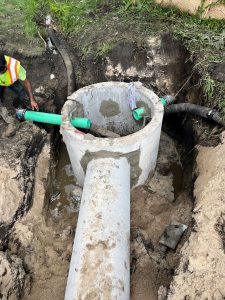County rolls out five-year road infrastructure project
By Gregory Harutunian For Chronicle Media — September 1, 2024
Lake County Division of Transportation crews install a sewer structure on Fairfield Road as part of the county’s road infrastructure Improvement program. (Photo courtesy of Lake County Division of Transportation)
The Lake County Board has approved a transportation program consisting of more than 300 improvement projects, designed to relieve congestion through roundabouts, resurfacing, additional turn lanes, and railroad bridge underpasses along Old McHenry Road.
The $850 million price tag is being supplied intermittently through various funding sources including federal and multi-jurisdictional collaborations.
In a statement, county officials said, “The program is designed to maintain the more than 900 lane miles of county highways, increase driver and pedestrian safety, increase mobility, and reduce carbon emissions. This program is updated annually to show the projects planned for the current year, and the next five years.”
The Lake County Division of Transportation also unveiled an interactive dashboard (lakecountyil.maps.arcgis.com) that will keep track of, and present status monitoring of the projects, as they are undertaken for 2024-29. The map shows an icon representing each project, and opening the symbol details the project and location.
Information on the map description indicates the immediate status of a project, cost factors, and continually updated information.
Chuck Gleason, LCDOT project manager, is heading two of the projects: the re-alignment of Cedar Lake Road in Round Lake, and railroad underpasses along Old McHenry Road in the area of Fairfield, Quentin, and Midlothian roads. The cost is estimated to be $150 million, with the goal to being to alleviate vehicle and pedestrian back-ups and congestion because of train traffic.
“Along with that, we are improving the intersections of Old McHenry, Midlothian, and Fairfield roads by adding turn lanes,” Gleason said. “Another thru-lane at the intersection will also work a lot better than what currently exists there. When trains go by, all the traffic stops, and backups clog all the lanes.”
The other project, which Gleason is overseeing, concerns a larger scope in downtown Round Lake. Metra commuter trains reaching the village’s train station often extend
onto Cedar Lake Road. Additional traffic issues embroil the parking lots at staggered times.
“It’s a big project where Route 134 meets Cedar Lake Road, and a four-way stop,” said Gleason. “We put in three lanes on Cedar Lake Road by Route 120, several years ago. We’re going straight instead of the curve there, and in 2050, there will be more traffic.

Route 41/Stearns School Road has been under construction for the last two months. Extended lanes of traffic aim to ease congestion during rush hour times. (Photo courtesy of Lake County Division of Transportation)
“The intersection will have a traffic signal and there is going to be a new train station, moving further east. We are working with Round Lake, Metra, the Illinois Department of Transportation, since Route 134 is their jurisdiction, and Pace, with their buses. It checks a lot of boxes, with safety for traffic and pedestrians.”
He also said the plan is an opportunity for Round Lake with vacant property becoming available for more downtown businesses and enhancing the current commercial district. The effort has begun its Phase II design and engineering portion, with job orders expected to go out for bid in 2027, and a tentative construction start that year.
The infrastructure plan has continued to evolve with projects being added, from nearly $650 million in 2022 to the present amount. The breakdown of the program cost shows the main contributions of $59.2 million supplied by the federal government, $169.6 million from the motor fuel tax allotment, and $392.3 million from the RTA sales tax.
All of the projects are spread throughout the county and have been identified as areas in need of improvement including the installation of roundabouts, as a safety measure for speed control and traffic flow.
Some projects are nearing completion such as the intersection improvement at Washington Street and Hunt Club Road, with shared use bike paths, and an expected completion date this fall.
“The program is based off of traffic projection, going out to the year 2050,” said Gleason. “In this way, what we are building will meet those estimates, and we won’t have to come back for reconstruction.”







